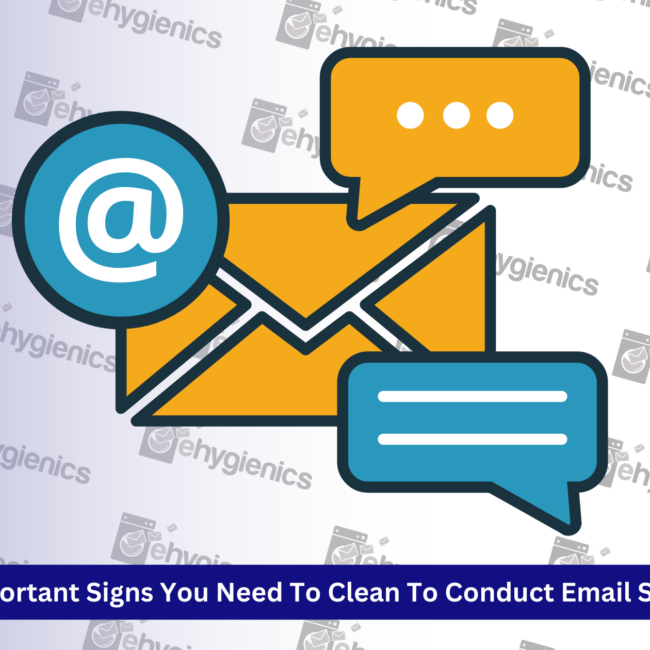What Is Email Hygiene And How To Perform It?
What Is Email Hygiene And How To Perform It?
Email marketing is a dynamic field. However, if your list is full of deadbeats, no amount of digital marketing effort will be successful. On the other hand, if mailbox providers (MBPs) and ISPs have blacklisted you, things will be even more difficult (for ISPs).
What is email hygiene?
The term “email list hygiene” refers to the practice of checking and correcting your information to make sure your mailing list is error-free.
So apart from avoiding spam complaints, keeping your list clean has other benefits, such as better email deliverability, a better reputation as a sender, and more money coming in from the email channel. And who wouldn’t want that?
How do several aspects affect the cleanliness of an email list?
A well-maintained email list depends on several different things. Ignoring the need for routine list maintenance might cause problems that prevent emails from reaching their intended recipients. In turn, this makes it less likely that people will respond positively and can throw your whole email campaign off track.
Among these are the following:
Non-active members: How often an email is considered “inactive” depends on the nature of your company and the frequency with which you communicate with clients. However, it is recommended that you eliminate subscribers who haven’t opened any of your emails in the past three to six months.
There’s a good chance that these contacts don’t want to get your emails but haven’t taken the time to unsubscribe yet. If you haven’t heard back from a contact in over a year, it’s possible that their email address has been reused as a spam trap.
If it has been less than six months since your last communication with an unresponsive contact, you can safely remove them from your active list for regular mailings and add them to a database for future re-engagement endeavors.
After 30 days, Gmail accounts that haven’t been used in a while will get a reminder to unsubscribe from email lists. This has led many senders to take extra steps to get rid of inactive users from their mailing lists.
Email addresses created with a specific function in mind are called “role accounts.” These accounts are not owned by a single person but rather are managed by a network of people who each have their own unique email address.
These addresses don’t usually sign up for email lists on purpose, and it’s not worth the risks to your sender reputation to keep sending email to them. Search your database for emails that begin with abuse@, postmaster@, info@, support@, etc.
spam traps that seem suspiciously like legitimate mailbox providers but are actually just typos (e.g., yahoooo.net or gmall.com). If you keep sending mail to these addresses, you risk getting into trouble because spammers routinely use them to trap other spammers.
Consider analyzing the open and click-through rates of certain email addresses in your mailing list. You may rest assured that emails sent to incorrect addresses will not be opened or clicked on, so you can stop sending them.
Low participation: Unsubscribe those who aren’t opening your emails or clicking on your links. The following are some of the things that MBPs and ISPs look for when gauging engagement:
Are these contacts new opt-ins? Have they lately authorized you to send them emails?
Purchases made in the last 120 days: Have they recently made a purchase related to your brand?
Current clicks and opens (during the last 120 days): Is there recent evidence that they are interested in your material and/or have clicked on any of your links?
When you get a negative response, it’s time to let them go.
Your email marketing campaigns are doomed to failure due to all of the above reasons. This soiled information will soon become part of a cold email list, increasing the likelihood of annoying spam complaints.
What is the solution then? Start scrubbing!
In just three easy steps, you can clean up your email list.
Knowledgeable email specialists will unequivocally state that high email performance is directly related to good, clean data. In order to get the most out of your email marketing efforts, it is important to regularly purge your list of potential recipients of your messages.
Is there a specific procedure for this? I suggest you start cleaning right away. That requires getting rid of any contacts that are dead, false, wrong, or otherwise useless. Here are some best practices for maintaining the cleanliness of your email list:
Determine inactive contacts.
Don’t be afraid to use the many tech tools you have at your disposal when you’re trying to clean up your list. Using data cleaning software, you can get rid of duplicates, fix formatting problems, and put all of your data in one place.
Before sending out campaigns, you should run your contact list through an email verification service to weed out any dead email addresses. Further, you can exclude people based on their bad habits. Messages sent from spam traps or role accounts aren’t going to be opened, so they’re a good candidate for a low-engagement filter.
In light of this, it is possible that you will wish to create a distinct subset from which to analyze those who did not answer but who otherwise meet the criteria.
Make an effort to re-engage
You should make an effort to reawaken your dormant connections before giving up on them entirely. Exactly what it sounds like, a re-engagement campaign is designed to do: A touch-base email (or series of emails) is sent out to a list of subscribers to check in with them and see whether they still want to be a part of your program.
Start by making a recency segmentation chart like the one shown here to find out where your value cliff is. This will help you find the best people to target with this kind of campaign. If you send emails to people who haven’t interacted with you in over six months, you can notice a drop in open rates and clickthroughs.
Eliminate inactive users.
You can remove the contacts from your list that you are certain will never engage once you have determined who does not belong there. When all else fails and you’ve tried to re-engage valid but unresponsive contacts, it’s time to delete them.
Although it may be upsetting to see good email addresses disappear, focusing on a smaller number of highly engaged readers is preferable to a larger but less engaged audience. Have faith; it will be beneficial to your sender’s reputation.
—–
If you’re looking for a reliable free email list cleaner, then visit Ehygienics.com. We offer the best spam trap cleaning services in the industry. Our professional technicians are experts at removing unwanted content from your website, and they will leave no trace behind.
Our team is dedicated to providing excellent customer service and ensuring that your business receives top-notch results every time we work with you. We offer free consultations, so feel free to contact us today!





